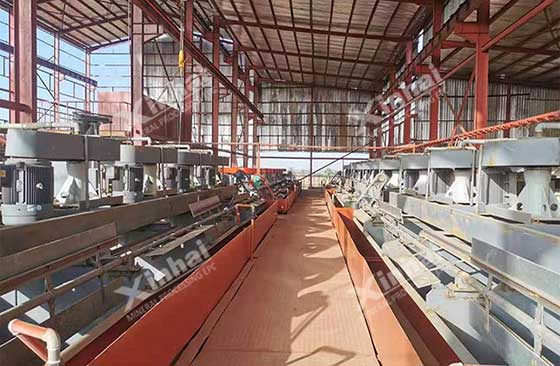
Gold occurs in various states in primary ores. According to this characteristic, cyanidation, gravity separation, magnetic separation, flotation and other methods can be selected to extract gold. Flotation is one of the important methods for treating gold-bearing ores. The flotation process includes material preparation, adjusting the pH value of the slurry, adding flotation reagents, flotation and other processes. The following will mainly introduce to you the characteristics of gold mines using flotation methods and the flotation methods of different types of gold mines to help you better understand gold mine flotation methods.

(flotation process)
1. Gold is mainly combined with sulfide;
2. If the gold is not mostly combined with the sulfide, the sulfide can ensure the formation of a stable foam layer;
3. If there is no sulfide in the ore but a large amount of iron oxide, ocher mud can be added to stabilize the foam;
4. If the ore contains neither sulfide nor iron oxide, but contains minerals that can enter the foam and stabilize the foam;
5. Pure quartz gold ore is pre-mixed with sulfide ore in a certain proportion, or appropriate chemicals are selected to promote the formation of stable foam;
6. After recovering the main metals in the ore by flotation, the tailings are treated with cyanide.

When gold ore containing high sulfide minerals is processed by flotation, gold particles can be effectively enriched in the concentrate of sulfide ore, and a large amount of tailings can be thrown away, which can reduce the cost of dressing and smelting. When polymetallic gold ores are treated by flotation, gold and other non-ferrous metal concentrates can be effectively separated, improving the comprehensive utilization of valuable minerals. If the gold ore is a refractory ore that cannot be treated by the mercury amalgamation process or the cyanide process, you can choose to use a combined beneficiation process including flotation process to increase the recovery rate of gold particles.
(1) Natural gold: The metal consists of easily floating minerals. In primary mineral deposits, natural gold often coexists with sulfide minerals such as pyrite, chalcopyrite, galena, and sphalerite. These sulfide ores that are symbiotic with gold are also easily floating minerals and can form stable mineralized foam, so they are ideal carrier minerals for gold mines. During flotation, gold particles can be enriched into concentrates of these sulfide minerals. Since the surface of natural gold has good hydrophobicity, it can be captured using sulfide minerals such as xanthate. Natural gold recovery can also use fine particle flotation methods such as carrier flotation and ion flotation.

(flotation process)
(2) Gold-bearing pyrite: The separation of pyrite and arsenopyrite is of great significance for the processing of gold-bearing arsenic sulfide ores. It is mainly based on the selective effect of lime, copper sulfate, inorganic oxidants, organic inhibitors and other chemicals on these two minerals. During flotation, you can first try to activate arsenopyrite with copper sulfate, and then preferentially float it out in the lime medium, while the pyrite remains in the flotation tank. To preferentially float out pyrite, enough ammonium chloride can be added to the lime medium during flotation to suppress arsenopyrite.
(3) Gold-bearing copper-lead-zinc sulfide ore: Generally, a copper-lead partial mixed flotation process is used, and then the mixed concentrate is separated to obtain copper concentrate and lead concentrate. Gold is often enriched in the copper concentrate. Due to the similar floatability of copper and lead sulfide minerals and the complex symbiotic relationship, the mixed concentrate is difficult to flotation separate, and thus qualified gold-containing copper concentrate and lead concentrate cannot be obtained. In order to improve the gold recovery rate, the carbonation conversion-flotation method can be used to process the gold-containing copper-lead mixed concentrate to comprehensively recover gold, silver and precious metals while separating copper and lead.
(4) Gold-bearing copper sulfide ore: Most of the natural gold in this ore exists in chalcopyrite and pyrite, and gold can be extracted by preferential flotation or mixed flotation. During flotation, lime can be added to the slurry to suppress pyrite, and copper sulfide will be preferentially flotated to obtain qualified gold-containing copper and sulfide concentrates.

(flotation site)
(5) Gold-bearing copper-iron ore: The main minerals are chalcopyrite and magnetite, and natural gold exists in chalcopyrite as fine particles. When processing this kind of ore, a combined process of flotation and magnetic separation can be used to obtain gold-containing copper concentrate and iron concentrate.
The above are the characteristics of flotation methods used in gold mines and the flotation methods of different types of ores. It can be seen from the above that different mineral processing processes are used for different types of ores. In order to improve the recovery rate of gold and the comprehensive utilization rate of ore, it is necessary to design a reasonable mineral processing process according to the occurrence state of gold in the ore and production requirements to avoid unnecessary resources waste and costs lost .
To find out more about our products and solutions, please fill out the form below and one of our experts will get back to you shortly.